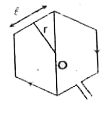Consider a circular current-carrying loop of radius R in the x-y plane with centre at origin. Consider the line integral ζ(L)=∣∣∣∫L−L→B.d→l∣∣∣ taken along z-axis.
(a) Show that ζ(L) monotonically increases with L.
(b) Use an appropriate Amperian loop to show that ζ(∞)=μ0I, where I is the current in the wire.
(c) Verify directly the above result.
(d) Suppose we replace the circular coil by a square coil of sides R carrying the same current I. What can you say about ζ(L) and ζ(∞)?
To solve the problem step-by-step, we will address each part of the question sequentially.
Part (a): Show that ζ(L) monotonically increases with L.
1. Understanding the Magnetic Field: The magnetic field B due to a circular current-carrying loop at a point along the z-axis can be derived using the Biot-Savart law. The magnetic field at a distance z from the center of the loop is given by:
\(
B(z) = \frac{\mu_0 I R^2}{2(R^2 + z^2)^{3/2}}
\)
where μ₀ is the permeability of free space, I is the current, and R is the radius of the loop.
2. Line Integral Definition: The line integral ζ(L) is defined as:
\(
ζ(L) = \left| \int_{-L}^{L} \vec{B} \cdot d\vec{l} \right|
\)
Since we are integrating along the z-axis, d→l is in the z-direction.
3. Evaluating the Integral: The magnetic field B(z) is symmetric about the origin. Therefore, the integral can be simplified:
\(
ζ(L) = 2 \int_{0}^{L} B(z) \, dz
\)
4. Monotonicity: As L increases, the upper limit of the integral increases, and since B(z) is always positive for z>0, the integral will increase. Thus, ζ(L) is a monotonically increasing function of L.
\(
B(z) = \frac{\mu_0 I R^2}{2(R^2 + z^2)^{3/2}}
\)
where μ₀ is the permeability of free space, I is the current, and R is the radius of the loop.
\(
ζ(L) = \left| \int_{-L}^{L} \vec{B} \cdot d\vec{l} \right|
\)
Since we are integrating along the z-axis, d→l is in the z-direction.
\(
ζ(L) = 2 \int_{0}^{L} B(z) \, dz
\)
Topper's Solved these Questions
- MAGNETIC EFFECT OF CURRENT AND MAGNETISMBOOK - PRADEEPCHAPTER - MAGNETIC EFFECT OF CURRENT AND MAGNETISMEXERCISE - Conceptual Problems (d)
2 Videos
- MAGNETIC EFFECT OF CURRENT AND MAGNETISMBOOK - PRADEEPCHAPTER - MAGNETIC EFFECT OF CURRENT AND MAGNETISMEXERCISE - Very Short Answer Questions (a)
2 Videos
- ELECTROSTATICSBOOK - PRADEEPCHAPTER - ELECTROSTATICSEXERCISE - ASSERTION-REASON TYPE QUESTIONS
2 Videos
- OPTICSBOOK - PRADEEPCHAPTER - OPTICSEXERCISE - Multiple choice questions
1 Videos
Similar Questions
Two identical wires each of length L are bent to form a circular loop and a square loop. If the same current i flows in the two wires, then the ratio of the magnetic inductions at the centre of the circular and square loops is :
View SolutionFind the magnetic field B at the centre of a rectangular loop of length l and width b, carrying a current i.
View Solution
Knowledge Check
The magnetic field at centre of a hexagonal coil of side l carrying a current I is
 A√3μ0IπlBμ0I4πlCπμ0I√3lDzero
A√3μ0IπlBμ0I4πlCπμ0I√3lDzeroA current carrying circular loop of radius R is placed in the x-y plane with centre at the origin. Half of the loop with x>0 is now bent so that it now lies in the y-z plane.
AThe magnitude of magnetic moment now diminishesBThe magnetic moment does not changeCThe magnitude of →B at (0,0,z),z>>R increasesDThe magnitude of →B at (0,0,z),z>>R is unchangedThe magnetic field at the point of intersection of diagonals of a square wire loop of side L, carrying a current I is
Aμ0IπLB2μ0IπLC√2μ0IπLD2√2μ0IπL
The magnetic field at the centre of an equilateral triangular loop of side 2L and carrying a current i is
View SolutionA circular loop of radius r, carrying a current I lines in y - z plane with its centre at the origin. The net magnetic flux through the loop is
View SolutionA square conducting loop of side length L carries a current I.The magnetic field at the centre of the loop is
View SolutionA circular current carrying loop of radius R, carries a current l. The magnetic field at a point on the axis of coll is 1√8 times the value of magnetic field at the centre. Distance of point from centre is
View SolutionA coil of length L, carries a current i. The magnetic moment of coil is proportional to
View Solution
